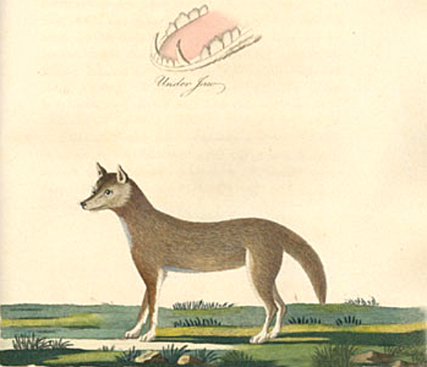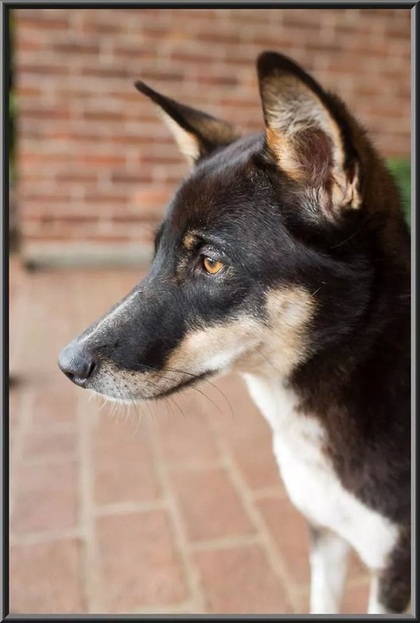DOG, WOLF OR DINGO?
|
Until recently, the formal physical description of the dingo was penned by Australia’s first governor Arthur Phillip – all the way back in 1788. Despite containing a limited level of detail in its one paragraph, this and its accompanying illustration is what was referred to when distinguishing pure dingoes.
For the first time in March 2014, a more detailed and benchmark physical description was produced for the purebred dingo. A team of scientists at University of New South Wales conducted research, published in the Journal of Zoology, based on data collected from 69 forensic specimens predating 1900 – a time frame in which it is known that dingoes had not come in to contact with domestic dogs. Interestingly, the findings revealed that many of our current perceptions of the physical attributes of pure dingoes are in fact incorrect. One of the most important findings was in regards to the colour of pure dingoes. It was found to not solely be yellow – a common misconception – but also four other basic pelage colours a pure dingo can have: brown, ginger/red, black and white. It’s significant to note that these colours can occur in various combinations – not just one in its entirety. For example, black and tan – just like Dingo Den’s own beautiful Khya. Sadly, this indicates that it’s likely that Phillip’s out-dated description has meant that pure dingoes have been culled due to them being mistaken for hybrids. The findings also led the research team to believe that the dingo should have its own place on the evolutionary tree, resulting in the resurrection of the scientific name Canis dingo. In fact, this was the name originally proposed by German naturalist Friederich Meyer in 1793. However, due to the great debate about how dingoes first came to inhabit Australia, as well as its genetic lineage, other names have been used - Canis lupus dingo (indicating a connection to the wolf - lupus) and Canis familiaris dingo (implying domestication). Adding weight to the University of New South Wales recommendation is the biggest genetic study yet into the origin of dogs. Scientists in the USA took the full genome of the dingo and compared it with that of the basenji (an ancient breed of dog originating in central Africa), the domestic boxer from Europe and the genomes of grey wolves from China, Croatia and Israel. This is the first study to compare the entire genetic sequences of dogs and wolves in such a way. It uncovered that all the wolves were more closely related to one another than to the dogs; and also that the dingo, basenji and boxer were more closely related to one another than any were to the wolves. This implies that dogs evolved earlier than first thought, possibly in a single location, and from a relative of grey wolves that is now extinct. Therefore, if dingoes and dogs evolved from another wolf-like ancestor there is a strong argument that they should not be referred to as a subspecies of Canis lupis, but species in their own rights. The notion that the dingo should be recognised as a separate species was further strengthened in March, 2019, when a paper by Smith et al was published in Zootaxa. In this paper, it was shown that even though dingoes can produce fertile offspring with dogs, they should not be considered the same species. This is because wolves, coyotes, jackals, and dogs are also able to hybridise with each other, however there is no argument that they should be considered a single species. Furthermore, it was shown that dingoes have distinct morphological features, especially of the cranium, that distinguish them from domestic dogs, including the similar-looking village dogs of South Eastern Asia.. This new paper also highlighted that a comparison of a variety of genetic tests and markers showed dingoes to be a distinct, highly divergent population, different from domestic dogs and other wild canines. Additionally, the paper detailed how dingoes exhibit behaviours separate to domestic dogs. This includes having a distinct breeding season, having territorial and pack behaviour, and howling to defend territory. Dingoes have been shown to be highly intelligent, and differ to dogs in problem solving. Finally, dingoes inhabit a unique ecological niche in Australia that the domestic dog is unable to fill, due to them lacking the adaptations and intelligence of the dingo. One of the most important implications of the resurrection of Canis dingo is that it brings hope that - if officially recognised as its own species – the protection they so rightly deserve will follow. |
The findings also led the research team to believe that the dingo should have its own place on the evolutionary tree, resulting in the resurrection of the scientific name Canis dingo. An illustration of a dingo from Arthur Phillip’s Voyage of Governor Phillip to Botany Bay, 1789.
Black dingoes account for around 8% of the natural dingo population.
|












